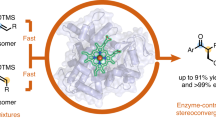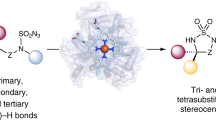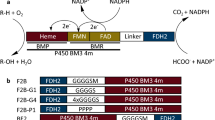Abstract
We have converted cytochrome P450 BM-3 from Bacillus megaterium (P450 BM-3), a medium-chain (C12–C18) fatty acid monooxygenase, into a highly efficient catalyst for the conversion of alkanes to alcohols. The evolved P450 BM-3 exhibits higher turnover rates than any reported biocatalyst for the selective oxidation of hydrocarbons of small to medium chain length (C3–C8). Unlike naturally occurring alkane hydroxylases, the best known of which are the large complexes of methane monooxygenase (MMO) and membrane-associated non-heme iron alkane monooxygenase (AlkB), the evolved enzyme is monomeric, soluble, and requires no additional proteins for catalysis. The evolved alkane hydroxylase was found to be even more active on fatty acids than wild-type BM-3, which was already one of the most efficient fatty acid monooxgenases known. A broad range of substrates including the gaseous alkane propane induces the low to high spin shift that activates the enzyme. This catalyst for alkane hydroxylation at room temperature opens new opportunities for clean, selective hydrocarbon activation for chemical synthesis and bioremediation.
This is a preview of subscription content, access via your institution
Access options
Subscribe to this journal
Receive 12 print issues and online access
$209.00 per year
only $17.42 per issue
Buy this article
- Purchase on Springer Link
- Instant access to full article PDF
Prices may be subject to local taxes which are calculated during checkout




Similar content being viewed by others
Accession codes
References
Chen, H.Y., Schlecht, S., Semple, T.C. & Hartwig, J.F. Thermal, catalytic, regiospecific functionalization of alkanes. Science 287, 1995–1997 (2000).
Hartmann, M. & Ernst, S. Selective oxidations of linear alkanes with molecular oxygen on molecular sieve catalysts—a breakthrough? Angew. Chem. Intl. Edn. 39, 888–890 (2000).
Thomas, J.M., Raja, R., Sankar, G. & Bell, R.G. Molecular sieve catalysts for the regioselective and shape-selective oxyfunctionalization of alkanes in air. Accounts Chem. Res. 34, 191–200 (2001).
Ashraf, W., Mihdhir, A. & Murrell, J.C. Bacterial oxidation of propane. FEMS Microbiol. Lett. 122, 1–6 (1994).
Watkinson, R.J. & Morgan, P. Physiology of aliphatic hydrocarbon-degrading microorganisms. Biodegradation 1, 79–92 (1990).
Leadbetter, E.R. & Foster, J.W. Incorporation of molecular oxygen in bacterial cells utilizing hydrocarbons for growth. Nature 184, 1428–1429 (1959).
Scheller, U., Zimmer, T., Kargel, E. & Schunck, W.H. Characterization of the n-alkane and fatty acid hydroxylating cytochrome P450 forms 52A3 and 52A4. Arch. Biochem. Biophys. 328, 245–254 (1996).
Stevenson, J.A., Westlake, A.C.G., Whittock, C. & Wong, L.L. The catalytic oxidation of linear and branched alkanes by cytochrome P450(cam). J. Am. Chem. Soc. 118, 12846–12847 (1996).
Fox, B.G., Froland, W.A., Jollie, D.R. & Lipscomb, J.D. Methane monooxygenase from Methylosinus trichosporium Ob3b. Methods Enzymol. 188, 191–202 (1990).
Fisher, M.B., Zheng, Y.M. & Rettie, A.E. Positional specificity of rabbit CYP4B1 for omega-hydroxylation of short-medium chain fatty acids and hydrocarbons. Biochem. Biophys. Res. Com. 248, 352–355 (1998).
Benson, S., Oppici, M., Shapiro, J. & Fennewald, M. Regulation of membrane peptides by Pseudomonas plasmid alk regulon. J. Bacteriol. 140, 754–762 (1979).
Schmid, A. et al. Industrial biocatalysis today and tomorrow. Nature 409, 258–268 (2001).
Boddupalli, S.S., Estabrook, R.W. & Peterson, J.A. Fatty-acid monooxygenation by cytochrome P450 BM-3. J. Biol. Chem. 265, 4233–4239 (1990).
Narhi, L.O. & Fulco, A.J. Characterization of a catalytically self-sufficient 119,000-dalton cytochrome P450 monooxygenase induced by barbiturates in Bacillus megaterium. J. Biol. Chem. 261, 7160–7169 (1986).
Miura, Y. & Fulco, A.J. ω-1, ω-2, and ω-3 hydroxylation of long-chain fatty acids, amides, and alcohols by a soluble enzyme system from Bacillus megaterium. Biochim. Biophys. Acta 338, 305–317 (1975).
Farinas, E.T., Schwaneberg, U., Glieder, A. & Arnold, F.H. Directed evolution of a cytochrome P450 monooxygenase for alkane oxidation. Adv. Synth. Catal. 343, 601–606 (2001).
Munro, A.W., Lindsay, J.G. & Coggins, J.R. Alkane metabolism by cytochrome P450 BM3. Biochem. Soc. T. 21, 412S (1993).
Schwaneberg, U., Otey, C., Cirino, P.C., Farinas, E. & Arnold, F.H. Cost-effective whole-cell assay for laboratory evolution of hydroxylases in Escherichia coli. J. Biomol. Screen 6, 111–117 (2001).
Schwaneberg, U., Schmidt-Dannert, C., Schmitt, J. & Schmid, R.D. A continuous spectrophotometric assay for P450 BM-3, a fatty acid hydroxylating enzyme, and its mutant F87A. Anal. Biochem. 269, 359–366 (1999).
Shanklin, J., Achim, C., Schmidt, H., Fox, B.G. & Munck, E. Mossbauer studies of alkane omega-hydroxylase: evidence for a diiron cluster in an integral-membrane enzyme. Proc. Natl. Acad. Sci. USA 94, 2981–2986 (1997).
Fox, B.G., Froland, W.A., Dege, J.E. & Lipscomb, J.D. Methane monooxygenase from Methylosinus trichosporium Ob3b—purification and properties of a 3-component system with high specific activity from a Type-Ii methanotroph. J. Biol. Chem. 264, 10023–10033 (1989).
Tonge, G.M., Harrison, D.E. & Higgins, I.J. Purification and properties of the methane mono-oxygenase enzyme system from Methylosinus trichosporium OB3b. Biochem. J. 161, 333–344 (1977).
Green, J. & Dalton, H. Substrate-specificity of soluble methane monooxygenase—mechanistic implications. J. Biol. Chem. 264, 17698–17703 (1989).
Murrell, J.C., Gilbert, B. & McDonald, I.R. Molecular biology and regulation of methane monooxygenase. Arch. Microbiol. 173, 325–332 (2000).
Staijen, I.E., van Beilen, J.B. & Witholt, B. Expression, stability and performance of the three-component alkane mono-oxygenase of Pseudomonas oleovorans in Escherichia coli. Eur. J. Biochem. 267, 1957–1965 (2000).
Zimmer, T., Ohkuma, M., Ohta, A., Takagi, M. & Schunck, W.H. The CYP52 multigene family of Candida maltosa encodes functionally diverse n-alkane-inducible cytochromes P450. Biochem. Biophys. Res. Commun. 224, 784–789 (1996).
Groves, J.T. & Han, Y.Z. Models and mechanisms of cytochrome P450 action. in Cytochrome P450: Structure, Mechanism, and Biochemistry 2nd Edn (ed. Ortiz de Montellano, P.R.) 3–48 (Plenum Press, New York, 1995).
Haines, D.C., Tomchick, D.R., Machius, M. & Peterson, J.A. Pivotal role of water in the mechanism of P450BM-3. Biochemistry 40, 13456–13465 (2001).
Li, H.Y. & Poulos, T.L. The structure of the cytochrome P450BM-3 haem domain complexed with the fatty acid substrate, palmitoleic acid. Nat. Struct. Biol. 4, 140–146 (1997).
Paulsen, M.D. & Ornstein, R.L. Dramatic differences in the motions of the mouth of open and closed cytochrome P450BM-3 by molecular dynamics simulations. Proteins 21, 237–243 (1995).
Chang, Y.T. & Loew, G. Homology modeling, molecular dynamics simulations, and analysis of CYP119, a P450 enzyme from extreme acidothermophilic archaeon Sulfolobus solfataricus. Biochemistry 39, 2484–2498 (2000).
Noble, M.A. et al. Roles of key active-site residues in flavocytochrome P450 BM3. Biochem. J. 339, 371–379 (1999).
Appel, D., Lutz-Wahl, S., Fischer, P., Schwaneberg, U. & Schmid, R.D. A P450BM-3 mutant hydroxylates alkanes, cycloalkanes, arenes and heteroarenes. J. Biotechnol. 88, 167–171 (2001).
Joo, H., Lin, Z.L. & Arnold, F.H. Laboratory evolution of peroxide-mediated cytochrome P450 hydroxylation. Nature 399, 670–673 (1999).
Cirino, P.C. & Arnold, F.H. Regioselectivity and activity of cytochrome P450 BM-3 and mutant F87A in reactions driven by hydrogen peroxide. Adv. Synth. Catal. in press (2002).
Reipa, V., Mayhew, M.P. & Vilker, V.L. A direct electrode-driven P450 cycle for biocatalysis. Proc. Natl. Acad. Sci. USA 94, 13554–13558 (1997).
Mathys, R.G., Schmid, A. & Witholt, B. Integrated two-liquid phase bioconversion and product-recovery processes for the oxidation of alkanes: process design and economic evaluation. Biotechnol. Bioeng. 64, 459–477 (1999).
Omura, T. & Sato, R. The carbon monoxide-binding pigment of liver microsomes. I. Evidence for its hemoprotein nature. J. Biol. Chem. 239, 2370–2378 (1964).
Zhao, H.M., Giver, L., Shao, Z.X., Affholter, J.A. & Arnold, F.H. Molecular evolution by staggered extension process (StEP) in vitro recombination. Nat. Biotechnol. 16, 258–261 (1998).
Yeom, H. & Sligar, S.G. Oxygen activation by cytochrome P450BM-3: effects of mutating an active site acidic residue. Arch. Biochem. Biophys. 337, 209–216 (1997).
Modi, S. et al. Nmr-studies of substrate-binding to cytochrome P450 (BM3): comparisons to cytochrome P450 (cam). Biochemistry 34, 8982–8988 (1995).
Acknowledgements
This work was supported by the National Science Foundation, the Max Kade Foundation (fellowship to A.G.), and by Maxygen. The authors also thank Nathan Dalleska for his assistance with GC/MS, and Ulrich Schwaneberg (International University, Bremen, Germany), Tom Poulos (University of California, Irvine, USA), and Andrew Munro (University of Leicester, UK) for helpful discussions. Correspondence and requests for material should be addressed to F.H.A.
Author information
Authors and Affiliations
Corresponding author
Ethics declarations
Competing interests
The authors declare no competing financial interests.
Rights and permissions
About this article
Cite this article
Glieder, A., Farinas, E. & Arnold, F. Laboratory evolution of a soluble, self-sufficient, highly active alkane hydroxylase. Nat Biotechnol 20, 1135–1139 (2002). https://doi.org/10.1038/nbt744
Received:
Accepted:
Published:
Issue Date:
DOI: https://doi.org/10.1038/nbt744
This article is cited by
-
Cytochrome P450 for environmental remediation: catalytic mechanism, engineering strategies and future prospects
World Journal of Microbiology and Biotechnology (2024)
-
Enantioselective oxidation of unactivated C–H bonds in cyclic amines by iterative docking-guided mutagenesis of P450BM3 (CYP102A1)
Nature Synthesis (2022)
-
Optimisation of Cytochrome P450 BM3 Assisted by Consensus-Guided Evolution
Applied Biochemistry and Biotechnology (2021)
-
Bacterial cytochrome P450-catalyzed regio- and stereoselective steroid hydroxylation enabled by directed evolution and rational design
Bioresources and Bioprocessing (2020)
-
Horizontal ‘gene drives’ harness indigenous bacteria for bioremediation
Scientific Reports (2020)



